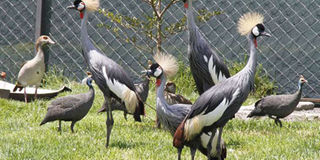Diary of a poultry farmer: Ostriches to guinea fowls, you can keep any bird of the bush

Crown birds, Egyptian Goose and Guinea fowls reared at Tausi Farm, Nairobi. PHOTO | JEFF ANGOTE | NATION MEDIA GROUP
What you need to know:
- Guinea fowls' natural habitats are forests, bushes and grasslands. They feed on seeds, tubers, crawling insects, rodents, small reptiles and occasionally vegetation and fruits.
- Their ability to fly offers them protection from predators.
- The age of sexual maturity for the guinea fowl is two years and they can weigh up to 1.8kg.
- Unlike with chicken where one has to wait for 21 days, with guinea fowls, they take 26 to 28 days.
Cleopas, my farm manager, had some good news weeks ago. The guinea fowls I had transferred from my farm in Busia to Nairobi some three months ago had started laying.
To be honest, I had missed their stuttering and grating ‘keerrrr’ sound. For my son, Baraka, and daughter, Amani, this was like an early Christmas gift since they always had to wait a year to interact with these birds.
“How many eggs are there?” I asked Cleopas.
“Two, so far,” he responded with his usual wry smile that says, “You see, I did it, again.”
If you are a regular, you remember I started rearing these birds three years ago on my rural farm. My decision was informed by the need to diversify my investments and spread risks.
For newcomers, allow me to walk you down the memory lane. In Busia, I reared these birds under free-range system as opposed to regimentation.
As you might have guessed, their natural habitats are forests, bushes and grasslands. They feed on seeds, tubers, crawling insects, rodents, small reptiles and occasionally vegetation and fruits.
For nesting, their preferred location is in long grass and bushes.
Therefore, they preferred to fly over the chain link fence to lay eggs in the bushy neighbourhoods.
Many times I was compelled to spend days looking for their eggs. Often, I was unlucky as they would have been eaten by dogs and other predators.
ORNAMENTAL GRASS AND SOME SHRUBS
Others would be stolen by those fetching firewood or grazing cattle.
I figured out that the best option was to transfer the birds to my farm in Nairobi to care for them better. To do this, I needed to figure out the means of transport.
You see, my mechanic, Wanyoike, had warned me that my weather-beaten 4.2–litre 1991 diesel-fired six cylinder Nissan Patrol was due for the 10-year overhaul.
Since I didn’t want to risk, I asked Cleopas to use the overnight bus.
I sighed with relief when he landed safely in Nairobi at 5am with seven guinea fowls and one turkey in a specially-made cage. I had made sure he carried with him the licence.
Unfortunately two days later, one guinea fowl was killed by the turkey. This was unusual because by their nature, guinea fowls are agile fliers although in most cases you will find them running instead.
Their ability to fly offers them protection from predators. I later learnt that the guinea fowl that was killed had a broken leg and, a result, it could not perch on the wood rails.
After the incident, I decided to separate the turkey from the guinea fowls and change the design of the coop.
The coop now includes a run enclosed within a chain link to allow them to free-range and get fresh air and sunshine. I have planted ornamental grass and some shrubs.
The walls are covered with wire mesh and a net. I have also provided adequate rails for perching.
YOU CAN DOMESTICATE ANY WILD BIRD
Now, this is important if you plan to rear these birds. I have observed that they never sleep on the floor. As soon as it gets dark, they jump, one-by-one to the highest point to perch.
What still puzzles me is their conditions for laying eggs. You see, I had assumed that if you confine guinea fowls to a room and feed them on layers mash, they will not lay eggs.
But I was surprised when Cleopas told me they had started laying eggs. This has made me realise that you can domesticate any wild bird, make them a nest to lay eggs, hatch them and smile all the way to the bank.
The age of sexual maturity for the guinea fowl is two years and they can weigh up to 1.8kg. I am told they can live up to 15 years, meaning, I still have some moments with my flock since the oldest is barely five years.
Another thing I was unsure of was their sexes. Guinea fowls are monomorphic and monochromatic. What these big words simply mean is that both sexes look and act alike.
Although they have laid eggs before, I wasn’t sure of their sexes or if all of them had attained sexual maturity.
So the eggs were a blessing. Two birds have been laying since then. I have now instructed Cleopas to identify two broody hens to use for hatching the keets.
Unlike with chicken where one has to wait for 21 days, with guinea fowls, they take 26 to 28 days. I will keep you posted.




